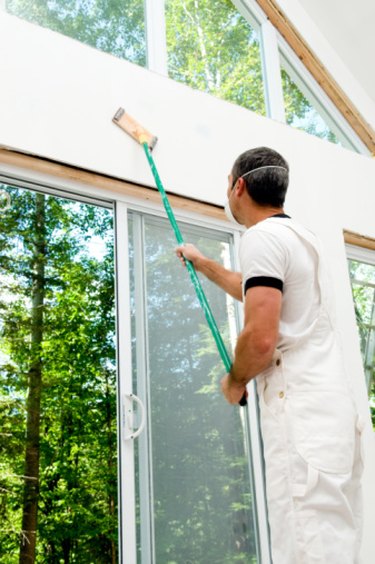Things You'll Need
Measuring tape
Carpenter’s square
Utility knife
Drywall screw gun
Drywall mesh tape
Joint compound
Drywall taping tools
Drywall sander

Drywall panels, made from tightly compressed gypsum particles and covered with thick paper, offer a smooth interior wall surface. Unfortunately, drywall is relatively soft and vulnerable to moisture. Damage from an impact or a leak around a window can result in broken, crumbling or rotted drywall. You can repair the wall by replacing the damaged section with a new piece of drywall.
Remove Damage
Step 1
Measure a rectangle, from the outside edge of the window to the nearest stud on the other side of the damaged section. You can locate the stud by rapping on the wall with your knuckles and listening for a "solid sound," or by using an electronic stud finder.
Video of the Day
Step 2
Use a carpenter's square to draw a rectangle that matches the measurements on a new piece of drywall.
Step 3
Cut out the new drywall section using the utility knife. To make the cut straighter, hold the edge of the carpenter's square along the line and cut beside it.
Step 4
Place the newly cut drywall rectangle over the damaged section, and trace around it – drawing an outline on the wall.
Step 5
Cut along the line and pry the old drywall section out; remove any drywall screws that held it in place.
Step 6
Scrape away dust and debris from the hole and position the new section of drywall in the hole. Since you used the piece as a template, it should fit evenly in the hole.
Step 7
Insert screws through the new drywall into the studs beneath at the rate of one screw every 8 inches, along the studs that lie beneath.
Finishing Drywall
Step 1
Cut and apply drywall mesh tape over the new joints, but don't overlap the tape. You'll need four pieces, one for each side of the rectangle.
Step 2
Apply about ½ cup of premixed joint compound with a 6-inch taping knife to the seams, pressing the semi-solid compound through the mesh and into the joint beneath. Smooth the surface of the compound along the seam as you go.
Step 3
Smooth out the wet compound further with a 10-inch taping knife. The wider knife ensures a flatter seam.
Step 4
Let the joint compound dry completely, and sand away rough areas with a drywall sander. Repeat the process by adding two more thin coats of drywall compound, letting each one dry before sanding smooth.
Step 5
Brush away drywall dust and paint your newly repaired wall to match your existing wall.
Tip
Work quickly once you begin applying the joint compound. On a hot dry day, the compound may begin to harden within a few minutes.
Warning
Cover your furniture and carpeting before sanding drywall. The dust is very fine and travels quickly through the air.
Video of the Day